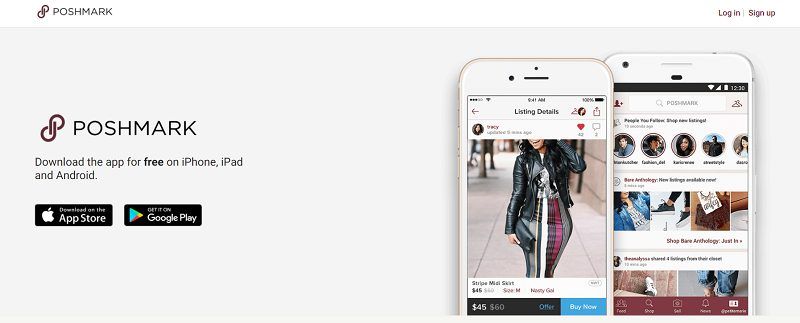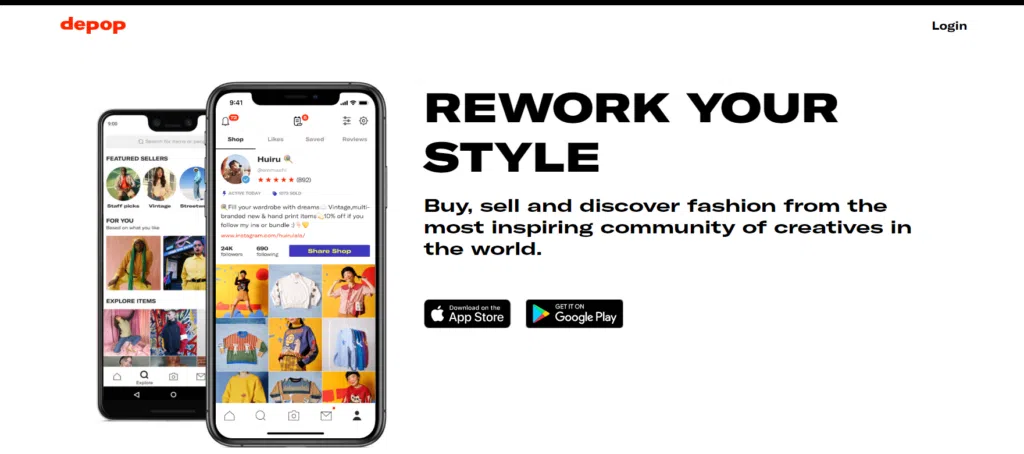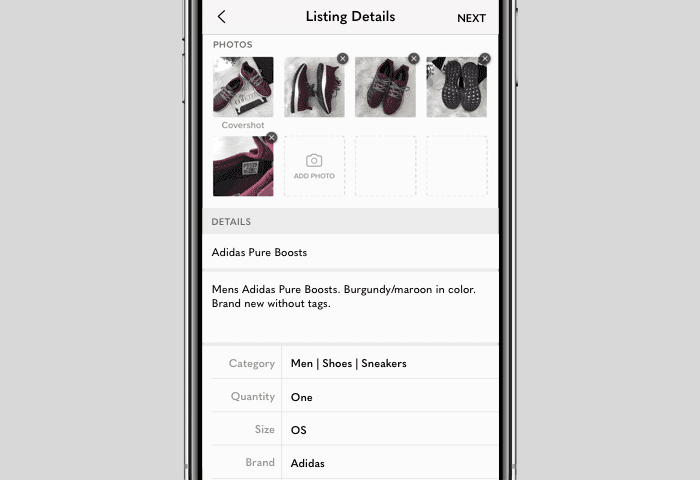Depop vs Poshmark For Sellers - The Ultimate Guide

If you want to make quick cash, selling clothing and accessories you don’t wear anymore is a great option to consider.
And the great news is that these days, there are somany online platforms you can use to find buyers. This helps you showcase your clothing and other items to interested buyers, helping you make sales quickly while streamlining the sales process.
Two of the biggest platforms for selling and buying second-hand clothes are Poshmark and Depop.
Each marketplace has hundreds of thousands of buyers and sellers. And they’re both an excellent way to clean out your home for extra cash.
But is Depop or Poshmark better for sellers? And how can you pick the right platform to ensure you earn as much as possible?
In this Depop vs Poshmark breakdown, I’m covering everything you need to know about each marketplace to choose the right one for you.
About Depop
Depop started out as a social network where readers of the magazine PIG could buy items featured in their publications.
Since then, the platform has grown into a global marketplace with a social element where you can see what your friends and people you are inspired by are buying, selling, and liking.

Depop is a wholly-owned subsidiary of Etsy. And there are currently over 26 million people in the Depop community in over 150 countries, so it’s a pretty massive online marketplace.
Unlike Poshmark, Depop generally caters to a younger audience as 90% of the active users are below the age of 26. And the company gained a ton of popularity through TikTok in 2019 and became a Gen Z favorite.
Vintage and streetwear finds are a popular thing to sell on Depop. But you can also sell jewelry, accessories, shoes, sunglasses, handbags, and a variety of other men and women’s clothing.
About Poshmark
Poshmark is a social marketplace dedicated to new and secondhand styles for women, men, kids, pets, your home, and more.
The company began in 2011. Since then, Poshmark has grown to over 80 million members across the United States, Canada, and Australia, making it almost four times the size of Depop.

On Poshmark, the community is a diverse crowd who love to shop closets and boutiques as well as sell their own collections. And unlike Depop, the audience on Poshmark is said to be more of a millennial age range with an interest in mid to high-end products.
Women’s clothing is still Poshmark’s main category, and it’s an excellent place to sell dresses, jeans, sneakers, handbags, watches, necklaces, and other clothing and accessories.
However, Poshmark is also more diverse than Depop, and men’s and kid’s clothing, pet toys, and home goods are eligible for sale.
Additionally, people tend to browse Poshmark for brand names at a good price, whereas Depop often focuses on more unique vintage finds.
Depop vs Poshmark
Choosing the right platform to sell on can make a massive difference to your bottom line and how quickly you find buyers. After all, you want to sell to the right audience and avoid painful seller fees.
That’s why this Poshmark vs Depop article is going to compare these two platforms in terms of:
- Seller fees
- Trends and what sells well
- Shipping fees
- Social membership
- Ease of use
- Seller protection
- Getting paid
Seller Fees
One of the most important factors to consider in the Depop vs Poshmark debate are seller fees.
Seller fees are inevitable when it comes to using online platforms to sell your items. It’s the price you pay to have access to the wide-ranging audience of buyers they bring in.
Although there’s no escaping seller fees, you do have some control over the matter. Different platforms have different policies when it comes to fees and pricing your item with them in mind is key.
Depop Fees
Depop’s seller fees seem pretty low at just 10% which attracts sellers to the app. However, it’s important to know that this varies depending on where you’re selling from.
For example, sellers in the US pay an additional 2.9% fee + $0.30 added to the 10%. For sellers in the UK, this goes up to 3.4% + £0.30.
Poshmark Fees
Poshmark charges a $2.95 fee for items that are under $15 or a 20% fee for items over $15. It doesn’t make any money on the shipping label, sales tax, or transaction processing fee.
This means that for items over $15, selling on Depop is much cheaper than selling on Poshmark, even when you factor in payment processing fees.
Poshmark does have a little built-in calculator that will tell you as you price your item how much you will make after the deductions. But it’s pretty much always more expensive than selling on Depop.
Winner: Depop has lower seller fees than Poshmark.
Trends & What Sells
Choosing a winner between Poshmark or Depop can often come down to what you’re selling. This is because each platform’s audience prefers certain styles and trends, letting you find buyers more quickly.

Here’s a general breakdown of what sells well on apps like Depop and Poshmark:
- Depop: Depop has a more specific audience being mostly buyers in their teens, 20s, and 30s. The audience on Depop is into vintage and thrifted clothes, upcycled items, and authentic designer goods.
- Poshmark: The audience Poshmark brings tends to enjoy brand names more than Depop. This includes brands like Chanel, Gucci, Louis Vuitton, Coach, Nike, and Adidas. Designer and very high-end pieces can also sell well. Items you have from more unique and less well-known stores may do better on Depop.
Shipping Costs
Another aspect of selling on Depop or Poshmark are potential shipping costs and how the process works.
Thankfully, both Poshmark and Depop make the selling and shipping process quite simple and don’t have too many fees.
Poshmark Shipping
When you sell an item on Poshmark, you receive a shipping label to use to fulfill your order. Simply print it out, stick it to your parcel, and drop it off at your local mailbox or post office.
You can decide if the buyer pays for the shipping when you create your listing. Offering free or discounted shipping would take the shipping fees off of your profit but does create a good incentive for buyers.
Depop Shipping
Depop is partnered with USPS and US merchants can use their shipping labels for their sales. Like Poshmark, it’s up to you if you’re covering the price of the shipping label or not.
If for some reason you would like to handle the shipping yourself, outside of USPS, you can choose your own method. You also have the option of listing your items as available for domestic shipping, international shipping, or both.
Winner: It’s a tie: Poshmark and Depop are very similar in terms of shipping costs and process.
Social Aspects
Both Poshmark and Depop allow users to “share” their listings to boost them to the top of people’s newsfeeds to drive attention to listings.
Poshmark has some additional features and tools to help out sellers. For example “Posh Parties” are real-time shopping events where sellers can virtually meet up on the app to shop, share, and sell their items. There are 4 parties a day, each with specific themes.

On Poshmark people can also like and comment on your listings which can help your listings get noticed by a potential buyer.
Depop’s platform is structured more like a social media app where people only see your listings if they liked them or if they follow you.
This can be excellent if you have a decent social media following on TikTok or Instagram and want to send some of your audience to follow you on Depop. And this is once again why Depop is a bit more popular than Poshmark for younger audiences.
Additionally, on Depop, you can privately message a seller to negotiate sales or as questions whereas Poshmark only allows for communication to be held in comment form under a listing.
Ease-Of-Use
Both platforms are designed to be super easy for a user with any skill level when it comes to technology. Listing an item is simple and can be done in a matter of seconds.
Poshmark and Depop are pretty similar as the user bases have the same idea: selling clothes and items at a good resale value.
To use these apps as a seller, all you have to do is download the app, create an account, and create a listing. You then add photos of what you’re selling and add a description and your price.

However, while the platforms share a similar process of listing items, their shopping experiences are a little different.
In terms of the way you use and scroll through the apps, Poshmark is like Facebook, whereas Depop is more like Instagram. But overall, both apps are mobile-friendly and easy to navigate.
Seller Protection
While fraud and disputes between buyers and sellers are rare on both Depop and Poshmark, they can happen. And this is when having a robust seller protection policy becomes crucial.
Poshmark Seller Protection
Poshmark offers full protection to its sellers. If your parcel happens to get lost or damaged in the mail, it’s fully protected as long as you use the shipping label provided to you by Poshmark and it has been scanned.
For more expensive items ($400 and up) Poshmark requires a signature from the buyer upon the delivery of the item.
Depop Seller Protection
Depop’s protection is really just PayPal protection. So if you use Paypal money as your payment method when making a sale you have coverage under them. If you choose a different type of payment method, Depop does not cover you for anything.
**Winner:**Poshmark has better seller protection than Depop.
Getting Paid
When you make a sale on Poshmark, you get paid after your item is delivered to the customer and they accept it. Poshmark has up to three days after delivery to release the funds to you.
This can be a little frustrating if you need money tomorrow or in a short period of time to pay bills. But once you’re ready to cash out, the money is sent directly to your bank account with no additional fees.
With Depop, you don’t need to wait for your item to ship - you get paid as soon as your item sells. When you’re ready to cash out your money, you can choose to have it sent to a PayPal or Stripe account. It then takes up to 10 days to send to your account, or up to two working days from when your item reaches the buyer.
Both of these platforms have merchant fees so keep these in mind when pricing your item as you will have this additional deduction.
Is Selling On Depop Or Poshmark Better?
Depop is better than Poshmark for sellers if you’re selling anything vintage or trendy that appeals to a younger audience. It’s also better than Poshmark if you like the social selling aspect or have an existing audience on social media that you can promote your clothing to.
The lower selling fee on Depop is another factor that makes it popular (10% on all listings versus 20% or the $2.95 flat fee on Poshmark). And if you live outside of the U.S., Canada, and Australia, use Depop as Poshmark is only available in those 3 countries.
https://www.youtube.com/watch?v=3yPPSB3txvs
In contrast, Poshmark is better than Depop if you’re mostly selling designer or brand-name clothing that people love. The seller fees are higher, but for high-end pieces, you might find more buyers than when selling on Depop.
Personally, if I go through the process of taking the pictures and writing descriptions, I like to throw the listing on both platforms to gain more traction. At that point, it only takes a few extra seconds to list on the other platform and essentially doubles my chances of getting a sale.
Other Selling Platforms To Consider
Now that you know some of the main differences between Poshmark and Depop, here are a few other popular online and local selling sites you can also consider:
- Facebook Marketplace: A free selling site that’s great for selling clothes, furniture, toys, electronics, books, cars, and more!
- Mercari: Another leading selling app where you can list just about anything for sale.
- OfferUp: A popular app like Facebook Marketplace that’s also free for local sales.
- Worthy: A reputable way to sell jewelry, diamonds, engagement rings, and watches online.
Extra Reading- Poshmark vs Mercari For Sellers.
Tips For Selling On Depop Or Poshmark
If you want to sell on Depop or Poshmark, or even both platforms, here are a few tips you can keep in mind to help make the selling process easier:
- Take Numerous Photos: Upload numerous photos to help potential buyers have as much information as possible.
- Write Detailed Descriptions: Mention details like condition, size, brand, material, and if you’re from a pet-free or smoke-free home.
- Respond To Buyers Quickly: Selling on Poshmark and Depop is competitive, so respond to questions from potential buyers as quickly as possible so they don’t move on to another seller.
- Research The Competition: Take some time to research what similar items are selling for to your listing so you price yourself competitively.
Extra Reading - The Best Sites & Apps Like Poshmark.
Final Thoughts
I hope this Poshmark vs Depop breakdown helps you decide which selling app is right for you.
Honestly, both apps have immense potential for sellers due to their ease-of-use and large audiences. If you want to make money online by selling stuff, you really can’t go wrong.
If anything, try listing on both Depop and Poshmark to see which app works best for you. Just be mindful of fees so you earn as much as possible with this side hustle idea.
Looking for more money-making methods? Checkout: